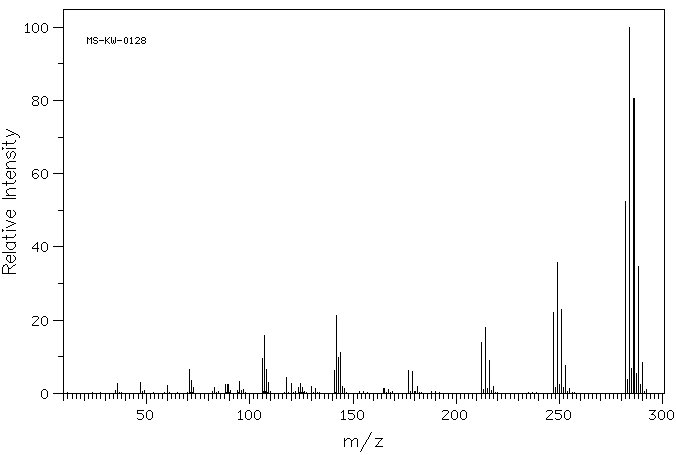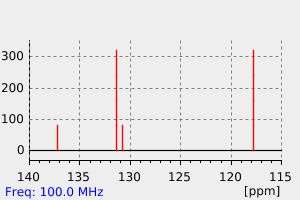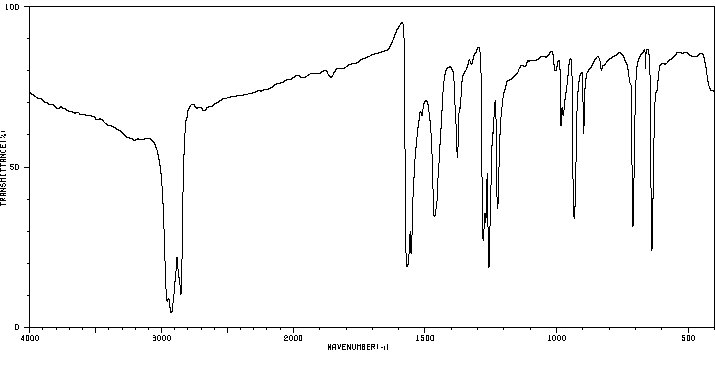富烯 | 6317-25-5
-
物化性质
-
计算性质
-
ADMET
-
安全信息
-
SDS
-
制备方法与用途
-
上下游信息
-
文献信息
-
表征谱图
-
同类化合物
-
相关功能分类
-
相关结构分类
计算性质
-
辛醇/水分配系数(LogP):4.5
-
重原子数:12
-
可旋转键数:0
-
环数:1.0
-
sp3杂化的碳原子比例:0.0
-
拓扑面积:0
-
氢给体数:0
-
氢受体数:0
SDS
上下游信息
-
下游产品
中文名称 英文名称 CAS号 化学式 分子量 —— 6-Methylpentachlorfulven 33834-99-0 C7H3Cl5 264.366
反应信息
-
作为反应物:参考文献:名称:Hexachlorofulvene. I. Synthesis and reactions under Diels-Alder conditions摘要:DOI:10.1021/jo00970a001
-
作为产物:参考文献:名称:Hexachlorofulvene. I. Synthesis and reactions under Diels-Alder conditions摘要:DOI:10.1021/jo00970a001
文献信息
-
Is Obsessive-Compulsive Disorder Caused by a Second-Messenger Imbalance?作者:Donatella Marazziti、Jorge Perez、Giovanni B. CassanoDOI:10.1017/s1092852900008579日期:2001.3
Abstract Although the precise etiologic nature of obsessive-compulsive disorder (OCD), one of the most common psychiatric conditions, is unknown, several findings indicate involvement of the serotonin (5-HT) transporter. Apart from the specific effects of selective 5-HT reuptake inhibitors, other studies show decreased functionality of the platelet 5-HT transporter in OCD. In this report, the authors combine data from two independent studies of patients with OCD, showing both an increased activity of protein kinase type C (PKC) and a decreased activity of protein kinase type A (PKA). The authors propose a unifying hypothesis that OCD might be determined by an imbalance between PKC and PKA, with a prevalence of the former and, more generally, of the phosphoinositide over the cyclic adenosine monophosphate (cAMP) pathway. Should this hypothesis prove correct, the path would be open for new therapeutic interventions in the treatment of OCD.
-
Isomerization of perchlorohexatriene in three consecutive rearrangements to perchloro-2-vinylbutadiene作者:Dieter Schollmeyer、Heiner DetertDOI:10.1016/j.tetlet.2017.01.040日期:2017.3three subsequent rearrangements to perchloro-2-vinylbutadiene. A radical-induced Z-E-equilibration of linear perchlorohexatrienes is followed by cyclization to a methylenecyclopentene. Under flash-vacuum pyrolysis conditions, a ring contraction to 1,2-dimethylenecyclobutane occurs. In the condensed phase, a radical-induced ring opening generates the branched perchloro-vinylbutadiene. All compounds are
-
Synthesis of Decorated Carbon Structures with Encapsulated Components by Low-Voltage Electric Discharge Treatment作者:I. V. Bodrikov、E. Yu. Titov、A. V. Vorotyntsev、V. I. Pryakhina、D. Yu. TitovDOI:10.1134/s0018143922010039日期:2022.2
Abstract Polycondensation of complexes of chloromethanes with triphenylphosphine by the action of low-voltage electric discharges in the liquid phase gives nanosized solid products. The elemental composition involving the generation of element distribution maps (scanning electron microscopy–energy dispersive X‑ray spectroscopy mapping) and the component composition (by direct evolved gas analysis–mass spectrometry) of the solid products have been studied. The elemental and component compositions of the result-ing structures vary widely depending on the chlorine content in the substrate and on the amount of triphenylphosphine taken. Thermal desorption analysis revealed abnormal behavior of HCl and benzene present in the solid products. In thermal desorption spectra, these components appear at an uncharacteristically high temperature. The observed anomaly in the behavior of HCl is due to HCl binding into a complex of the solid anion
$$\textHCl}}_2}^ - }$$ 摘要 在液相低压放电的作用下,氯甲烷与三苯基膦的络合物发生缩聚反应,生成纳米级固体产物。通过生成元素分布图(扫描电子显微镜-能量色散 X 射线光谱图)研究了固体产物的元素组成,并通过直接进化气体分析-质谱法研究了固体产物的成分组成。根据基质中氯的含量和三苯基膦的用量,生成物结构的元素和成分组成变化很大。热解吸分析表明,固体产品中的盐酸和苯的行为异常。在热解吸光谱中,这些成分出现在异常高的温度下。观察到的 HCl 行为异常是由于 HCl 与三苯基(氯甲基)氯化磷结合成了固体阴离子 $$\HCl}}_2}^ - }$$ 的复合物,这种复合物需要相对较高的温度(高达 800 K)才能分解。苯的异常行为与其在纳米结构中的封装状态有关。苯的出现从 650 K 开始,一直持续到 1300 K 以上的温度。 -
Comments on reactions of oxide derivatives of uranium with hexachloropropene to give UCl<sub>4</sub>
-
Thermal Rearrangements of Perchlorohexatrienes-Structures and Experimental and Theoretical Evaluation of Pathways to Isomerization and Cyclization作者:Heiner Detert、Dieter Lenoir、Hendrik ZipseDOI:10.1002/ejoc.200801076日期:2009.32 kJ mol–1. Unimolecular cis/trans isomerization is predicted to occur through an unusual vinylcyclobutene intermediate 7, whose formation faces a barrier of more than 150 kJ mol–1, but whose stability is comparable to that of 1 and 2. The isomerization rate is strongly enhanced by the addition of small amounts of Br2 or Cl2 or by 3 and can be explained by a radical-induced isomerization mechanism.我们已经通过已知途径制备了反式 (1) 和顺式八氯 1,3,5-己三烯 (2),并通过从头计算从实验和理论上研究了它们的热行为。1 和 2 中的三个双键由于八个 Cl 的空间位阻而完全解耦,如计算以及 1 的单晶 X 射线结构所示。顺式异构体 2 可以异构化为反式异构体 1通过将其加热至 220–250 °C,无论是纯净的还是溶解在高沸点溶剂中,产生大约 2:1 的反式和顺式异构体混合物。几个不同理论水平的计算预测 1 和 2 在 2 kJ mol-1 内是等能的。单分子顺式/反式异构化预计通过一种不寻常的乙烯基环丁烯中间体 7 发生,其形成面临超过 150 kJ mol-1 的障碍,但其稳定性与 1 和 2 相当。加入少量 Br2 或 Cl2 或加入 3 可大大提高异构化速率,可以用自由基诱导异构化机制来解释。三烯 1 和 2 加热到 250 °C 导致环化,产生 71% 的环戊烯异构体
表征谱图
-
氢谱1HNMR
-
质谱MS
-
碳谱13CNMR
-
红外IR
-
拉曼Raman
-
峰位数据
-
峰位匹配
-
表征信息









